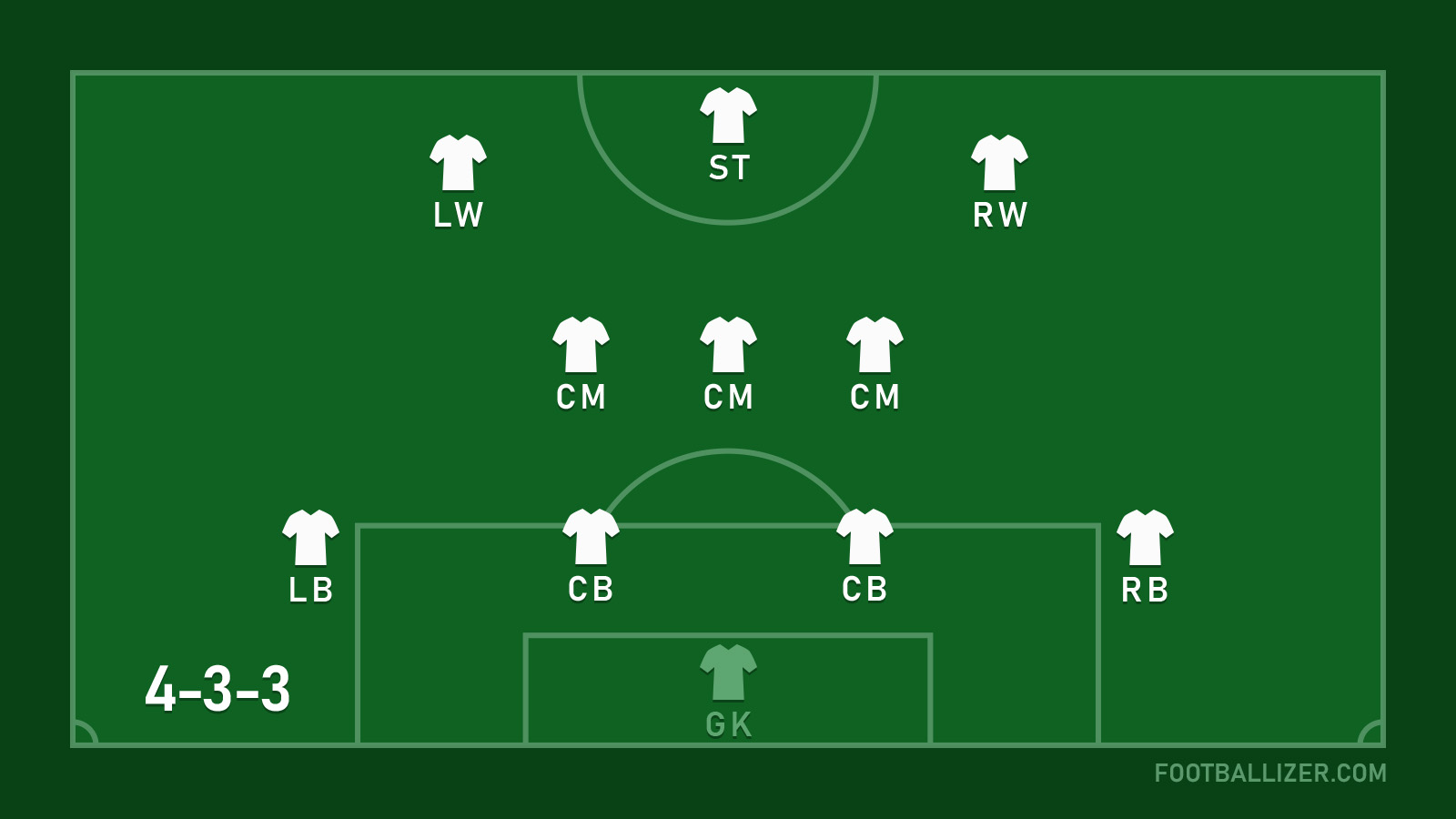4-3-3 Formation

The 4-3-3 formation is a popular and widely used soccer formation that has been employed by many top national and club teams around the world. It is a formation that provides both attacking and defensive options and is considered to be one of the most balanced formations in the game.
This formation can be considered an attacking formation as it involves having three forwards, four midfielders, and three defenders.
The 4-3-3 formation consists of four defenders, three midfielders, and three forwards. The four defenders are made up of two center-backs and two full-backs. The center-backs are responsible for defending the central areas of the pitch, while the full-backs are responsible for marking the opposing wingers and providing support in attack.
The three midfielders in a 4-3-3 formation are usually made up of one defensive midfielder and two attacking midfielders. The defensive midfielder is responsible for breaking up opposition attacks and providing cover for the defense, while the two attacking midfielders are tasked with creating chances for the forwards and supporting the attack.
The three forwards in a 4-3-3 formation are typically made up of one central striker and two wingers. The central striker is responsible for scoring goals and leading the attack, while the wingers are responsible for providing width and stretching the opposition defense.
Advantages
Lack of Width
The 4-3-3 formation relies heavily on the full-backs to provide width in attack. This means that if the opposition can effectively neutralize the full-backs, the team can struggle to create chances.
Vulnerability on the flanks
The 4-3-3 formation leaves the flanks exposed, as the wingers are often given the freedom to move up the field. This can make the team vulnerable to counter-attacks if the opposition can exploit the space behind the full-backs.
Difficulty in Midfield Control
With only three central midfielders, the 4-3-3 formation can struggle to control the midfield against teams that play with a four-man midfield. This can lead to the team being overrun in midfield, and struggling to create chances.
Lack of Support for the Striker
The lone striker in a 4-3-3 formation can often find themselves isolated, with little support from the midfield. This can make it difficult for them to hold up the ball and bring others into play.
Rigidity
The 4-3-3 formation can be rigid and predictable, with little variation in the team's play. This can make it easier for the opposition to defend against, as they know what to expect.
Disadvantages
Vulnerability on the Flanks
The diamond shape in midfield can leave the flanks exposed and vulnerable to opposition attacks. This can be a problem if the opposition has fast wingers or full-backs who can exploit the space on the flanks.
Lack of Width
The diamond shape in midfield can also limit the team's attacking options on the wings, as the midfielders tend to focus on the center of the pitch. This can make it difficult for the team to create scoring opportunities from crosses or cutbacks from the wings.
Dependence on the Attacking Midfielder
The attacking midfielder plays a crucial role in the 4-3-1-2 formation, as they are responsible for creating chances for the strikers. If the attacking midfielder is marked out of the game or underperforms, the team may struggle to create scoring opportunities.
Lack of Defensive Midfield Cover
With only one defensive midfielder in the 4-3-1-2 formation, the team may be vulnerable to counterattacks or opposition attacks that bypass the midfield. The defensive midfielder may also be overloaded and struggle to cover the entire midfield.
Difficulty in Transitioning from Defense to Attack
The diamond shape in midfield can make it difficult for the team to transition from defense to attack quickly, as the midfielders may need time to reposition themselves and provide passing options for the defense.
How to Counter 4-3-3 Formation?
Utilize the Flanks: As mentioned, the 4-3-3 formation can be vulnerable on the flanks. Opposing teams can exploit this weakness by using their own wingers to attack the space behind the full-backs. They can also use overlapping runs from their own full-backs to create overloads on the wings.
Crowd the Midfield: To counter the 4-3-3's midfield weakness, teams can deploy an extra central midfielder to gain numerical superiority in the middle of the pitch. This can make it difficult for the 4-3-3 team to control possession and create chances.
Target the Lone Striker: Since the 4-3-3 formation relies heavily on the lone striker, teams can deploy a tight man-marking system to prevent the striker from receiving the ball and creating chances. Alternatively, teams can use a deep-lying defensive midfielder to mark the striker and prevent them from turning and running at the defense.
Press high up the pitch: The 4-3-3 formation can struggle when pressed high up the pitch, as it limits the time and space the midfielders have to make decisions. Opposing teams can use a high-pressing system to force turnovers and create chances.
Play with width: To counter the 4-3-3's lack of width, teams can use a formation with natural wide players, such as a 4-4-2 or a 3-5-2. This can stretch the opposition defense and create space in the middle of the pitch for midfielders and strikers to exploit.
Suggested Counter Formations
- 4-4-2
- 4-2-3-1
- 3-5-2
- 5-4-1
- 4-1-4-1
- 4-5-1
- 3-4-3
- 5-3-2